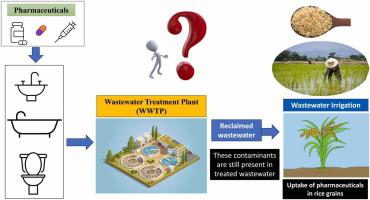当前位置:
X-MOL 学术
›
Environ. Toxicol. Pharmacol.
›
论文详情
Our official English website, www.x-mol.net, welcomes your
feedback! (Note: you will need to create a separate account there.)
Occurrence of pharmaceuticals in rice (Oryza sativa L.) plant through wastewater irrigation
Environmental Toxicology and Pharmacology ( IF 4.2 ) Pub Date : 2024-05-20 , DOI: 10.1016/j.etap.2024.104475 Khalid Sayed 1 , Wan Hanna Melini Wan-Mohtar 2 , Zarimah Mohd Hanafiah 3 , Aziza Sultana Bithi 1 , Nurulhikma Md Isa 4 , Teh Sabariah Binti Abd Manan 5
Environmental Toxicology and Pharmacology ( IF 4.2 ) Pub Date : 2024-05-20 , DOI: 10.1016/j.etap.2024.104475 Khalid Sayed 1 , Wan Hanna Melini Wan-Mohtar 2 , Zarimah Mohd Hanafiah 3 , Aziza Sultana Bithi 1 , Nurulhikma Md Isa 4 , Teh Sabariah Binti Abd Manan 5
Affiliation

|
The present investigation focuses on the identification of popular PhACs in roots, leaves and rice grains, which are cultivated in soil irrigated with waters and wastewater. The present study reveals the presence of PhACs in rice grains from different brands which are available in the current market, which has thus motivated these experiments. The rice plants were cultivated in garden containers and irrigated with three different water sources. All PhAC compounds were recovered within an 89–111 % range using the extraction technique, reproducibility, and sensitivity (LOQ <25 µg/g). Further, PhAC compounds were identified using liquid chromatography quadrupole time-of-flight mass spectrometry (LC-QqTOF-MS). Interestingly, several PhAC compounds were detected in rice grains, aligning with hypotheses and findings from published literature. A total of ten (10) PhACs were found in the root, leaf, and rice grain of the 20 popular PhACs that were targeted. The annual exposure and medical dose equivalent for individual PhACs was negligible. According to our knowledge, this study is the first to show the accumulation of several categories (cocktail) of PhACs in rice grains and show the approximate human health risk assessment by its consumption. The study's results provide valuable insights for researchers, policymakers, and agricultural practitioners working on sustainable agriculture and public health.
中文翻译:

废水灌溉导致水稻 (Oryza sativa L.) 植株中药物的产生
本研究的重点是鉴定在用水和废水灌溉的土壤中种植的根、叶和稻粒中常见的 PhAC。本研究揭示了当前市场上不同品牌的米粒中存在 PhAC,这激发了这些实验的进行。水稻种植在花园容器中,并用三种不同的水源进行灌溉。使用提取技术、重现性和灵敏度(LOQ <25 µg/g),所有 PhAC 化合物的回收率在 89-111% 范围内。此外,使用液相色谱四极杆飞行时间质谱 (LC-QqTOF-MS) 鉴定了 PhAC 化合物。有趣的是,在米粒中检测到了几种 PhAC 化合物,这与已发表文献的假设和发现相一致。在 20 种常见的目标 PhAC 的根、叶和米粒中总共发现了十 (10) 个 PhAC。单个 PhAC 的年暴露量和医疗剂量当量可以忽略不计。据我们所知,这项研究首次展示了米粒中几类PhAC(鸡尾酒)的积累,并通过食用米粒来显示对人类健康风险的大致评估。该研究结果为致力于可持续农业和公共卫生的研究人员、政策制定者和农业从业者提供了宝贵的见解。
更新日期:2024-05-20
中文翻译:

废水灌溉导致水稻 (Oryza sativa L.) 植株中药物的产生
本研究的重点是鉴定在用水和废水灌溉的土壤中种植的根、叶和稻粒中常见的 PhAC。本研究揭示了当前市场上不同品牌的米粒中存在 PhAC,这激发了这些实验的进行。水稻种植在花园容器中,并用三种不同的水源进行灌溉。使用提取技术、重现性和灵敏度(LOQ <25 µg/g),所有 PhAC 化合物的回收率在 89-111% 范围内。此外,使用液相色谱四极杆飞行时间质谱 (LC-QqTOF-MS) 鉴定了 PhAC 化合物。有趣的是,在米粒中检测到了几种 PhAC 化合物,这与已发表文献的假设和发现相一致。在 20 种常见的目标 PhAC 的根、叶和米粒中总共发现了十 (10) 个 PhAC。单个 PhAC 的年暴露量和医疗剂量当量可以忽略不计。据我们所知,这项研究首次展示了米粒中几类PhAC(鸡尾酒)的积累,并通过食用米粒来显示对人类健康风险的大致评估。该研究结果为致力于可持续农业和公共卫生的研究人员、政策制定者和农业从业者提供了宝贵的见解。











































 京公网安备 11010802027423号
京公网安备 11010802027423号